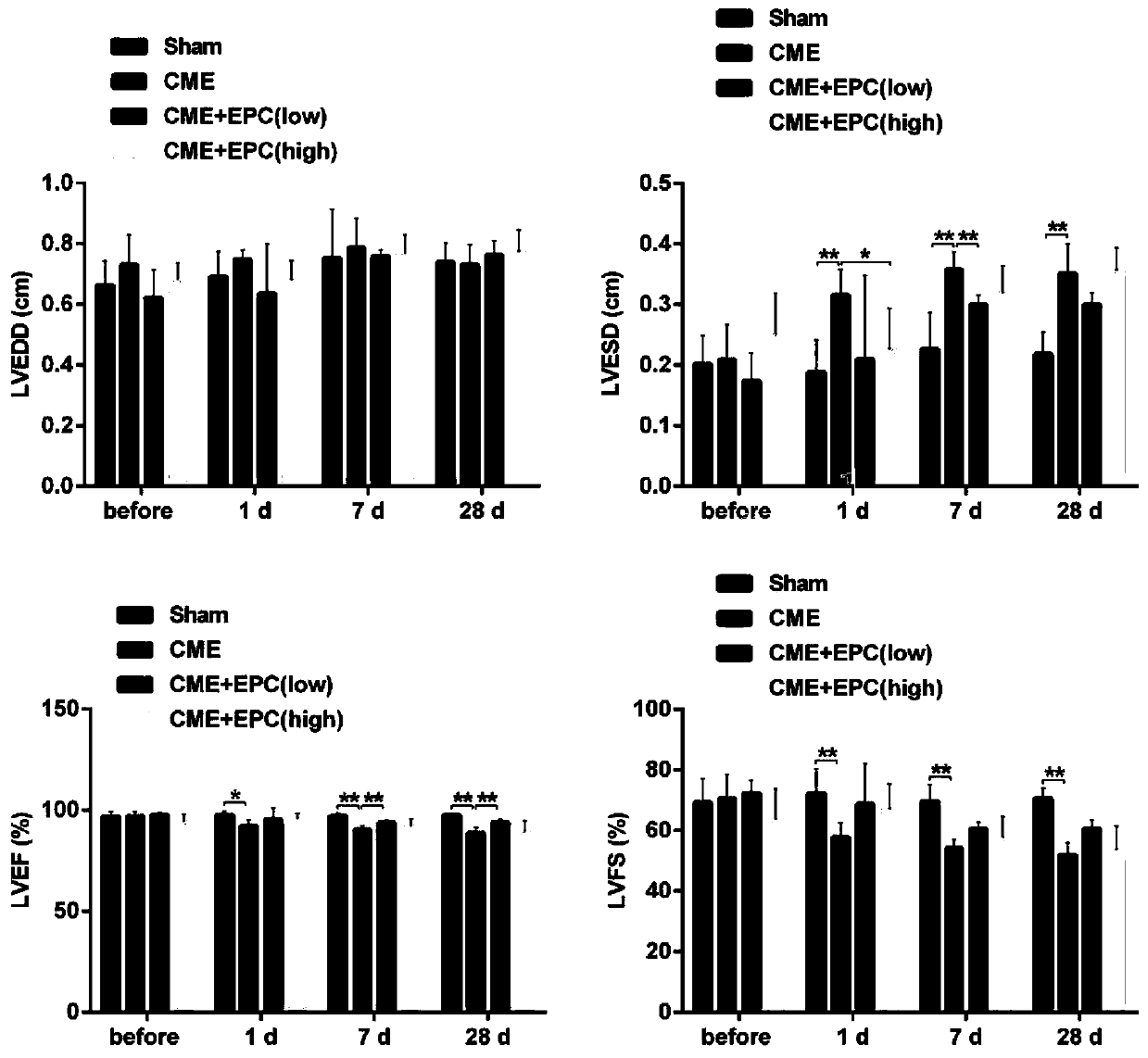Application of endothelial progenitor cells in transplantation treatment of coronary microembolization of mouse
A technology of endothelial progenitor cells and coronary arteries, applied in the application field of endothelial progenitor cells in the transplantation treatment of coronary artery microembolism, can solve the problems of lack of effective treatment methods for coronary artery microembolism, and achieve significant curative effect
- Summary
- Abstract
- Description
- Claims
- Application Information
AI Technical Summary
Problems solved by technology
Method used
Image
Examples
Embodiment 1
[0030] Example 1: Isolation and culture identification of EPC
[0031] 1. Extraction of EPCs
[0032] 1) Take SD rats with a mass of 200-250 g and an age of 8-9 weeks, weigh them, and anesthetize them with 5% chloral hydrate (0.6 mL / 100 g) by intraperitoneal anesthesia. remove. The rats were fixed in prone position, depilated, sterilized with iodophor alcohol, and covered with towels. Remove both legs of the SD rat with scissors. All surgical operations are performed by the same person, in order to reduce unnecessary errors that may be brought about during the operation.
[0033] 2) Roughly separate the flesh and bones of the removed two legs into a 50 mL centrifuge tube filled with 75% absolute ethanol, and then place the centrifuge tube in a transfer chamber for UV disinfection for 10 minutes.
[0034] 3) Take the sterilized centrifuge tube to the ultra-clean bench, take out the two legs, separate the femur and tibia with sterilized forceps and small scissors, and cut bo...
Embodiment 2
[0049] Example 2: Establishment of Rat Coronary Artery Microembolism Model
[0050] In this example, a rat coronary microembolization model was established:
[0051] 1. Experimental grouping
[0052] 1) Sham operation group (Sham)
[0053] 2) Coronary microembolization group (CME)
[0054] 3) Coronary microembolization (CME) & EPC transplantation group (low dose group)
[0055] 4) Coronary microembolization (CME) & EPC transplantation group (high dose group)
[0056] 2. Animal modeling
[0057] Half an hour before the operation, 10% trichloroacetaldehyde was used to anesthetize the rats at a dose of 3 μL / g. After the rats were anesthetized, 0.5 mL of blood was collected from the tail vein, and blood clots were formed in a 37°C incubator. The rat tail was electrocoagulated to stop bleeding, the chest was shaved, the trachea was intubated, and the ventilator was connected. The breathing ratio was 1:2, and the tidal volume was 18. The breathing rhythm of the rat was consiste...
Embodiment 3
[0082] Example 3: Detection of the effect of EPC transplantation in the treatment of coronary micro-embolism in rats
[0083] 1. Experimental grouping: the same as in Example 2.
[0084] 2. Animal modeling: the same as in Example 2.
[0085] 3 Immunohistochemical detection
[0086] 3.1 Preprocessing
[0087] Paraffin sections: dewaxed and hydrated according to conventional methods, soaked in xylene for 5 min, replaced xylene and then soaked for 5 min; soaked in absolute ethanol for 5 min; soaked in 95% ethanol for 5 min; soaked in 85% ethanol for 5 min ; Soak in 70% ethanol for 5 min, and soak in distilled water for 3 min × 3 times.
[0088] 3.2 Experimental steps
[0089] 1) Bake the slices at 37℃ overnight;
[0090] 2) Xylene 1, 2, 3 for 10min each, ethanol 100%, 95%, 90%, 80%, 70%, 50% for 2min each, distilled water for 1min;
[0091] 3) TBS wash 3 times, 5min each time;
[0092] 4) Antigen retrieval (high fire to boiling, turn to low fire for 20min), natural cooling...
PUM
 Login to View More
Login to View More Abstract
Description
Claims
Application Information
 Login to View More
Login to View More - R&D
- Intellectual Property
- Life Sciences
- Materials
- Tech Scout
- Unparalleled Data Quality
- Higher Quality Content
- 60% Fewer Hallucinations
Browse by: Latest US Patents, China's latest patents, Technical Efficacy Thesaurus, Application Domain, Technology Topic, Popular Technical Reports.
© 2025 PatSnap. All rights reserved.Legal|Privacy policy|Modern Slavery Act Transparency Statement|Sitemap|About US| Contact US: help@patsnap.com



